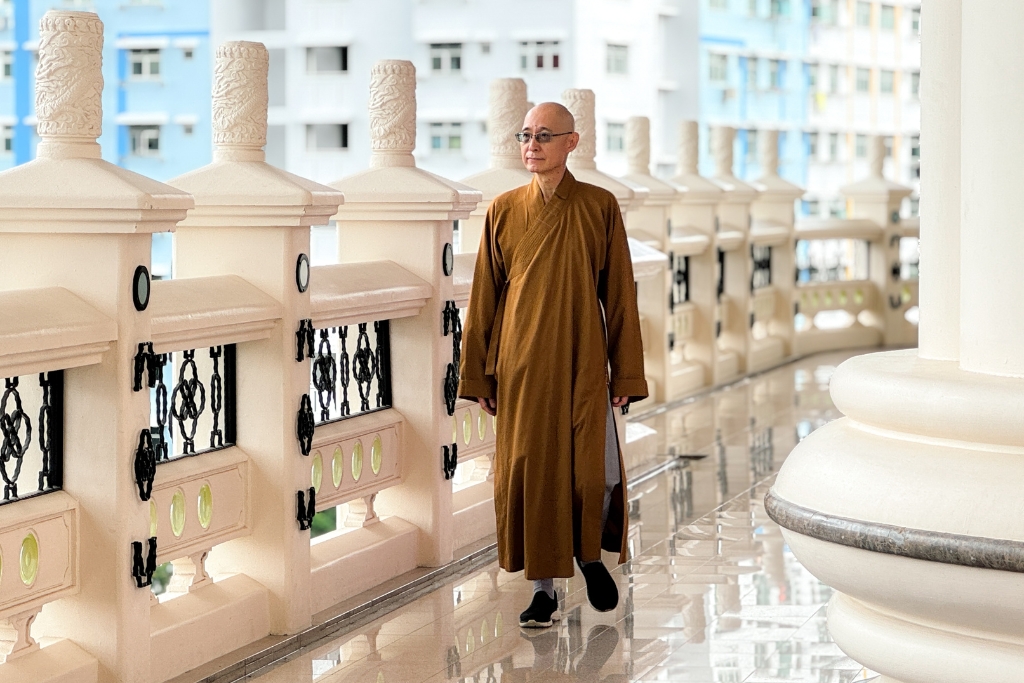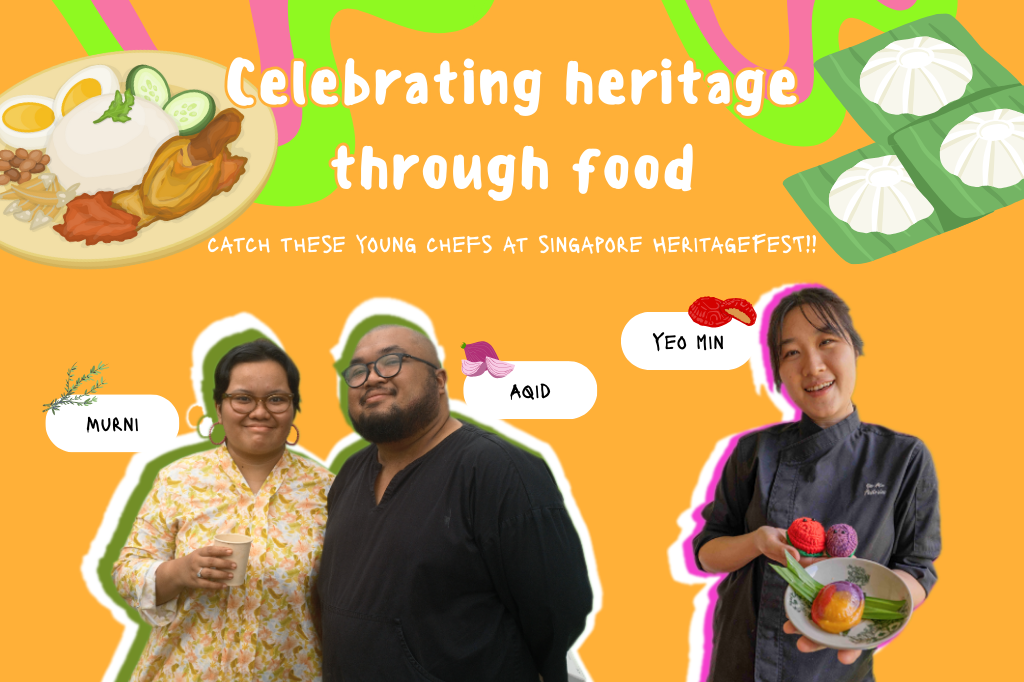Keepsakes of the Kristang Heritage
Being Singaporean has always been a matter of addition, and not subtraction. In multiracial Singapore, diverse races have influenced each other’s cultures all while retaining their own. These Eurasian youths share what being Kristang means to them, and how they keep in touch with their Eurasian roots.
- 5 Aug 2022

Andre and his family enjoying a home-cooked Christmas spread together.
First, gather spare parts – pig intestines, stomach, liver, ears, and all the rest of it. Then, dice them into precise 0.5cm cubes before frying. Last, and most importantly, add a unique powdered spice mix to top it all off. This is a curry like no other.
Curry feng consists primarily of spare offals and is just one of many lesser-known names in Kristang cuisine, according to 26-year-old Portuguese Eurasian, Andre D’Rozario. In Kristang, “feng” is speculated to be closely related to the word “fing”, meaning “end”, an allusion to the various odds and ends that make up the distinctively pungent dish.
“It’s one of those things that we make with whatever we have when we’re struggling and have to be frugal. I’d say this kind of dish exists in almost every community,” Andre explains.
Today, curry feng, along with other Kristang dishes like curry devil and sugee cake, can only be found at a few places in Singapore, he shares. These include his friend’s mother’s homemade catering business, Hollz Kitchen, Mary’s Kafe, and the Eurasian Association’s resident restaurant, Quentin’s.
Curry feng consists primarily of spare offals and is just one of many lesser-known names in Kristang cuisine, according to 26-year-old Portuguese Eurasian, Andre D’Rozario. In Kristang, “feng” is speculated to be closely related to the word “fing”, meaning “end”, an allusion to the various odds and ends that make up the distinctively pungent dish.
“It’s one of those things that we make with whatever we have when we’re struggling and have to be frugal. I’d say this kind of dish exists in almost every community,” Andre explains.
Today, curry feng, along with other Kristang dishes like curry devil and sugee cake, can only be found at a few places in Singapore, he shares. These include his friend’s mother’s homemade catering business, Hollz Kitchen, Mary’s Kafe, and the Eurasian Association’s resident restaurant, Quentin’s.
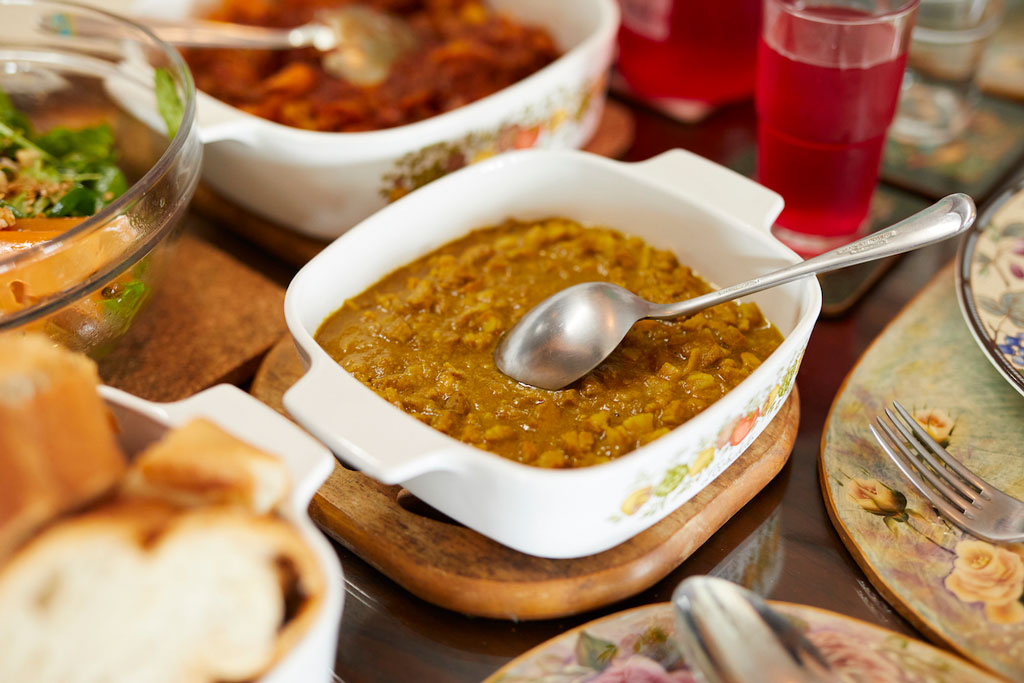
Andre's first attempt at curry feng, the star of the meal, under the guidance of his mother.
But Andre hasn’t always been this knowledgeable about his heritage.
Despite growing up surrounded by fellow Eurasians, it was only after attending his first Kristang language class at the age of 20 that he began to grapple with what it meant to be Kristang. A passionate activist eager to raise awareness of his heritage, he and many other Eurasian youths fervently continue to contribute to efforts in revitalising a little-known culture in Singapore today.
This hasn’t always been the case. In the years following the Portugese colonisation in 1511, inter-marriages between the Portuguese and local Malay women in Malacca were common. Many of these families eventually relocated to Singapore. The Kristang language was borne of extensive language contact between Portuguese and local Malays, even becoming a lingua franca in Malaya.
Speaking in Kris-tongue
A big part of the Kristang community’s revitalisation efforts surround their language. For many, language is the most intuitive indicator of cultural identity, and something that sets the Kristang community apart from their various other Eurasian counterparts.
In fact, picking up Kristang classes during his downtime while serving National Service was the catalyst for Andre’s reckoning with his Kristang roots in the first place.
“Of course you can be Eurasian without knowing the language lah, but it’s good for my sense of self. It has given me a greater sense of ownership over my culture and allowed me to tether myself to the region more securely.” As he says, being Kristang is intrinsically Singaporean, or Malayan, in itself – the culture cannot be found anywhere else in the world but in this region.
These classes were introduced under Kodrah Kristang (which translates to “Awaken, Kristang”), a non-profit initiative founded by Kevin Martens Wong, a 29-year-old Eurasian Eunoia Junior College teacher who started the project when he was a third-year linguistics undergraduate at the National University of Singapore. Set up in 2016, the initiative sought to kick-start the long, multi-generational process of revitalising the language and bringing it back to a healthy level of use.
Kodrah Kristang’s core curriculum consists of eight modules, with each one comprising 10 lessons of two hours each, amounting to a total of 160 hours of learning. The goal is for students to be able to proficiently manipulate units of the language for real conversational use by the end of the entire course. Although the class was taught by volunteers learning the language, native speakers were also present in class to support the volunteers and correct them where necessary.
Most importantly, having fun during lessons is a given.
“Each lesson is highly interactive and focuses on learning the language through games, conversation and interaction rather than bare worksheets and exercises,” Kevin, explains. “We recognised the need to not simply teach the language, but to build a community of learners who enjoyed each other's presence and therefore were more affectively incentivised to keep using the language.”
Despite growing up surrounded by fellow Eurasians, it was only after attending his first Kristang language class at the age of 20 that he began to grapple with what it meant to be Kristang. A passionate activist eager to raise awareness of his heritage, he and many other Eurasian youths fervently continue to contribute to efforts in revitalising a little-known culture in Singapore today.
A snapshot in time
“In modern-day Singapore, there are fewer than a hundred native Kristang speakers, and most are above 50,” he says. In future, there might not be any.”This hasn’t always been the case. In the years following the Portugese colonisation in 1511, inter-marriages between the Portuguese and local Malay women in Malacca were common. Many of these families eventually relocated to Singapore. The Kristang language was borne of extensive language contact between Portuguese and local Malays, even becoming a lingua franca in Malaya.
Speaking in Kris-tongue
A big part of the Kristang community’s revitalisation efforts surround their language. For many, language is the most intuitive indicator of cultural identity, and something that sets the Kristang community apart from their various other Eurasian counterparts.
In fact, picking up Kristang classes during his downtime while serving National Service was the catalyst for Andre’s reckoning with his Kristang roots in the first place.
“Of course you can be Eurasian without knowing the language lah, but it’s good for my sense of self. It has given me a greater sense of ownership over my culture and allowed me to tether myself to the region more securely.” As he says, being Kristang is intrinsically Singaporean, or Malayan, in itself – the culture cannot be found anywhere else in the world but in this region.
These classes were introduced under Kodrah Kristang (which translates to “Awaken, Kristang”), a non-profit initiative founded by Kevin Martens Wong, a 29-year-old Eurasian Eunoia Junior College teacher who started the project when he was a third-year linguistics undergraduate at the National University of Singapore. Set up in 2016, the initiative sought to kick-start the long, multi-generational process of revitalising the language and bringing it back to a healthy level of use.
Kodrah Kristang’s core curriculum consists of eight modules, with each one comprising 10 lessons of two hours each, amounting to a total of 160 hours of learning. The goal is for students to be able to proficiently manipulate units of the language for real conversational use by the end of the entire course. Although the class was taught by volunteers learning the language, native speakers were also present in class to support the volunteers and correct them where necessary.
Most importantly, having fun during lessons is a given.
“Each lesson is highly interactive and focuses on learning the language through games, conversation and interaction rather than bare worksheets and exercises,” Kevin, explains. “We recognised the need to not simply teach the language, but to build a community of learners who enjoyed each other's presence and therefore were more affectively incentivised to keep using the language.”
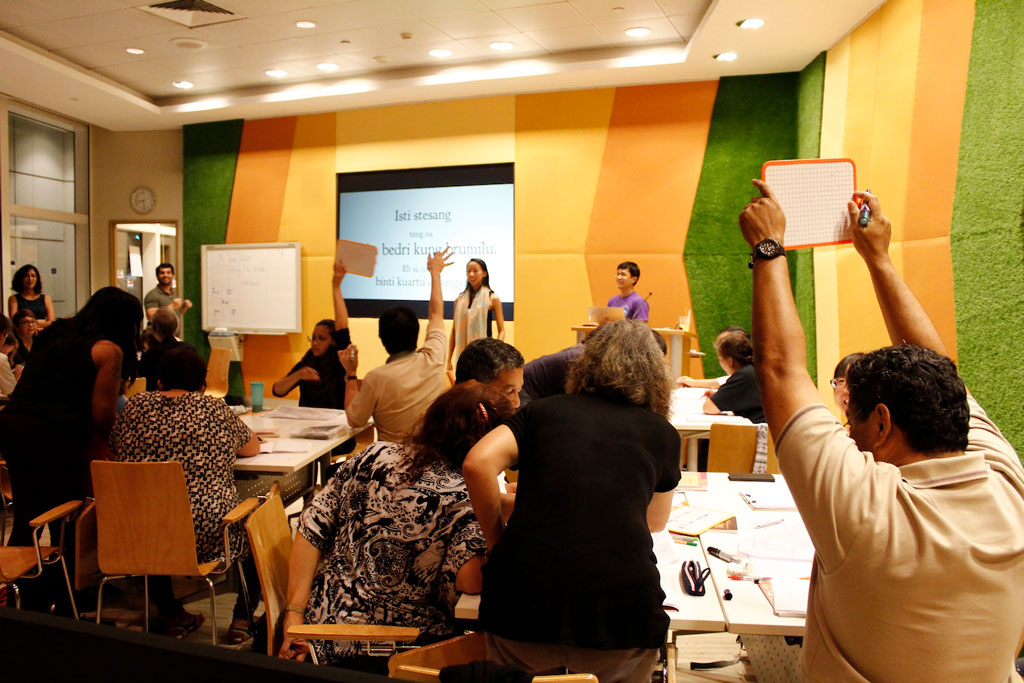
Kevin’s class is engaged in a competitive round of gamified learning. In this activity supporting students learning colours and numbers in Kristang, The names of various MRT stations were flashed, and students had to compete to identify its numerical station code and line colour in Kristang. Photo was taken pre-pandemic. Photo credit: Jeremy Ou/Kodrah Kristang.
Indeed, a close-knit community blossomed. Andre’s passion for the language led to him doubling up as a Level 1 Kristang teacher while he was still learning Level 2 Kristang. Although it is difficult to objectively assess a Kristang speaker’s competence when the language does not have a standardised written syllabus, the team has welcomed individuals like Andre, who have interest in returning as tutors. This spirit was encouraged by the first Kristang speaker who asked Kevin to start the classes, Bernard Mesenas, as he believes in developing a strong and inclusive network of people who support one another in learning and growing in the language.
Interestingly, there were no formal proficiency tests to qualify to teach – Andre only became a part-time teacher because he had enough commitment and interest. What’s more, it’s difficult to objectively assess a Kristang speaker’s competence when the language had originally arisen from informal contact and does not have a universal, standardised written syllabus today.
Nevertheless, there is still some consensus on common Kristang words and phrases. For instance, the universal “teng bong” for “hello”, “kumi” for “eat”, or “doi” for “money” – pertinent words in the Singaporean vocabulary.
One doesn’t have to be Eurasian to sign up for classes either – 30 per cent of students were non-Eurasians who were simply interested in picking up the language. Of course, those who have prior knowledge of Malay, Portuguese, or even Spanish will have a slightly easier time. Like most other contact languages, Kristang is derived from two different source languages – while its vocabulary mainly comes from Portuguese, its syntactical structure is closer to that of Malay.
Interestingly, there were no formal proficiency tests to qualify to teach – Andre only became a part-time teacher because he had enough commitment and interest. What’s more, it’s difficult to objectively assess a Kristang speaker’s competence when the language had originally arisen from informal contact and does not have a universal, standardised written syllabus today.
Nevertheless, there is still some consensus on common Kristang words and phrases. For instance, the universal “teng bong” for “hello”, “kumi” for “eat”, or “doi” for “money” – pertinent words in the Singaporean vocabulary.
One doesn’t have to be Eurasian to sign up for classes either – 30 per cent of students were non-Eurasians who were simply interested in picking up the language. Of course, those who have prior knowledge of Malay, Portuguese, or even Spanish will have a slightly easier time. Like most other contact languages, Kristang is derived from two different source languages – while its vocabulary mainly comes from Portuguese, its syntactical structure is closer to that of Malay.
Storytelling in alternative spaces
To raise awareness on his culture, Andre is using storytelling. With his expertise on storyboarding from his Diploma in Animation from LASALLE and the help of three like-minded friends, Shane Carroll, Gerald Choa and Sung Chang Da, the team published Singapore’s first graphic novel about the Kristang community, Ki Sorti.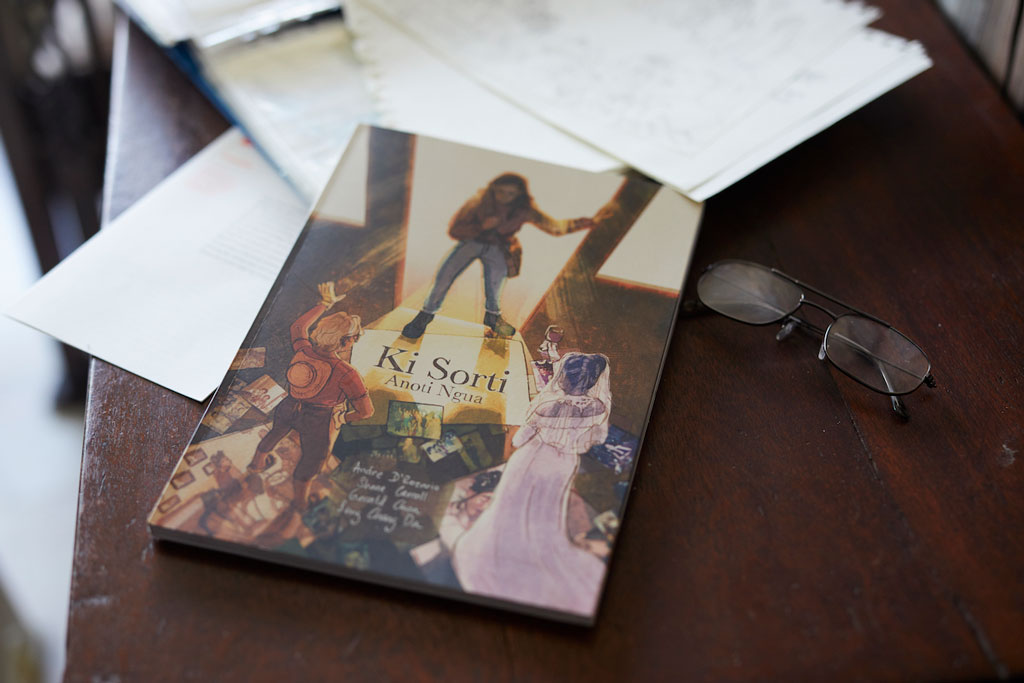
Volume 1 of Ki Sorti, also showcased during the month-long The Future of Our Pasts Festival in 2019. Organised by Yale-NUS College in conjunction with the Singapore Bicentennial, the festival allowed for young artists in Singapore to showcase their work in reimagining Singapore’s history.
The rationale was simple: Graphic novels were a nice compromise between reading a conventional novel and watching an animated film, given the team’s limited resources. Initially consisting of 66 pages, the work-in-progress has since burgeoned to 180 pages in the past two years.
Each chapter focuses on one character from a different time period, be it a middle-aged woman in the 50s or the main protagonist, a university student named Alex D’Almeida living in contemporary times. Some parts of certain chapters are even split down the middle, with one side in English and the other in Kristang. The goal is for history to be made intimate, personal, and digestible.
“I was very insistent on making all of them brown too, as a lot of Eurasians in the media look stereotypically European and fair-skinned,” Andre deadpans. With a soft smile, he continues, “Shane and I, in particular, have always wanted to create something we wish we had while growing up and honour the older generation, all in a medium we enjoy.”
Danni, 32, recalls a time when he was questioned for eating at a restaurant during Ramadan in Malaysia and took the opportunity to patiently explain his family heritage. “It’s because I look more Thai, Malay, Filipino, whatever you want to call me. But I always take out my IC as a starting point. There’s no other way to tell the story and it opens your eyes to different types of Eurasians.”
Each chapter focuses on one character from a different time period, be it a middle-aged woman in the 50s or the main protagonist, a university student named Alex D’Almeida living in contemporary times. Some parts of certain chapters are even split down the middle, with one side in English and the other in Kristang. The goal is for history to be made intimate, personal, and digestible.
“I was very insistent on making all of them brown too, as a lot of Eurasians in the media look stereotypically European and fair-skinned,” Andre deadpans. With a soft smile, he continues, “Shane and I, in particular, have always wanted to create something we wish we had while growing up and honour the older generation, all in a medium we enjoy.”
No one way to be Kristang
Ultimately, shedding light on the community can only be sustained through everyday dialogue and discourse. Sometimes, it just takes a simple question to spark an educational conversation.Danni, 32, recalls a time when he was questioned for eating at a restaurant during Ramadan in Malaysia and took the opportunity to patiently explain his family heritage. “It’s because I look more Thai, Malay, Filipino, whatever you want to call me. But I always take out my IC as a starting point. There’s no other way to tell the story and it opens your eyes to different types of Eurasians.”
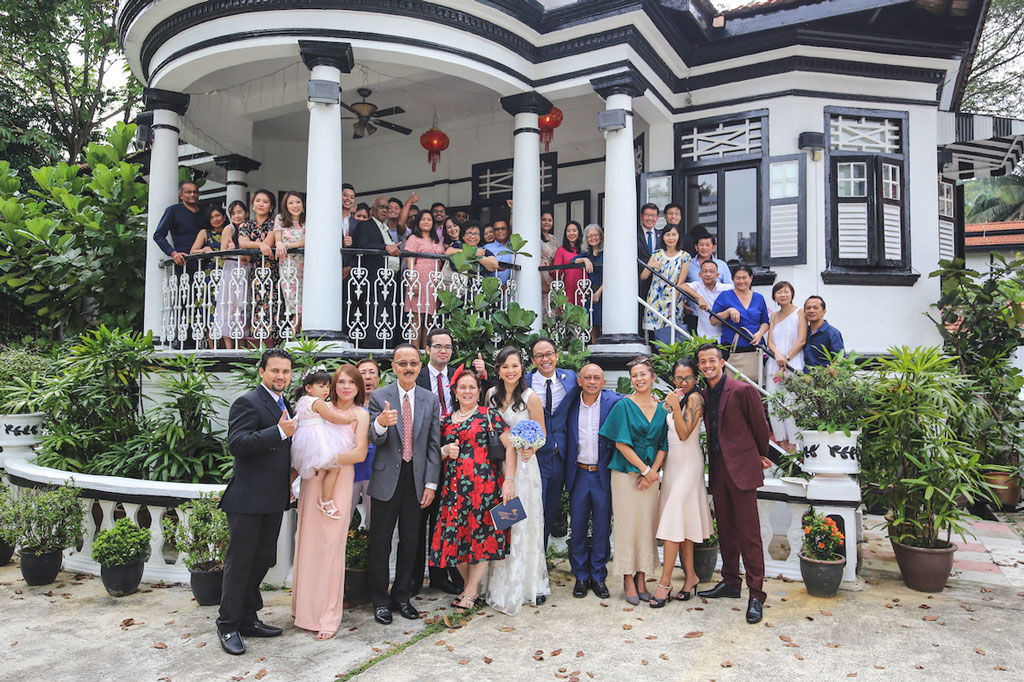
Danni (first row, fifth from the right) and his diverse extended family at his wedding in March 2019. Photo credit: Danni Jay Luke Danis.
For Andre, it’s about equipping himself with the knowledge from his family so that he can share it with future generations. Besides learning to cook more family dishes, he is grateful to have the privilege of taking time off every week to learn to sew with his grandma, who is a major inspiration for his graphic novel.
While sewing is not unique to Eurasians, it is Andre’s personal take on staying connected to his roots. For him, culture is not measured by tangible, recognisable public standards but is a personal endeavour. “Being more DIY, more crafty – that’s what I associate with Eurasians. My dad was a carpenter and my grandma a painter, when I was born.”
While sewing is not unique to Eurasians, it is Andre’s personal take on staying connected to his roots. For him, culture is not measured by tangible, recognisable public standards but is a personal endeavour. “Being more DIY, more crafty – that’s what I associate with Eurasians. My dad was a carpenter and my grandma a painter, when I was born.”
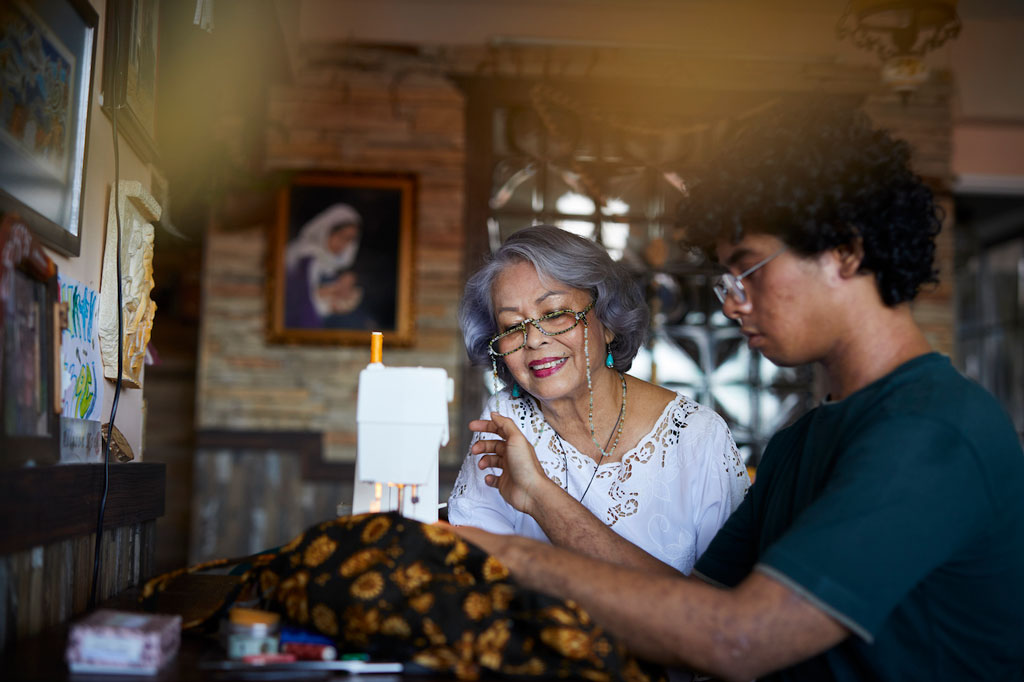
Andre working on a pair of floral overalls, made from batik fabric from his grandma’s old stash.
His long-term goal is to eventually phase out his old wardrobe and replace it entirely with self-made clothes. It’s a revolt against fast fashion, but with strong emotional underpinnings.
At the end of the day, Andre remains cautiously optimistic about the future of his community.
“It’s difficult for me to say that Kristang will die out. I’d like to think it won’t and it’ll just keep evolving – it’ll remain in a book, a dictionary, someone’s photos.”
At the end of the day, Andre remains cautiously optimistic about the future of his community.
“It’s difficult for me to say that Kristang will die out. I’d like to think it won’t and it’ll just keep evolving – it’ll remain in a book, a dictionary, someone’s photos.”
Learn some Kristang!
| Kristang | Meaning |
| Teng bong | Hello |
| Bong anoti | Goodnight |
| Mutu merseh | Thank you |
| Ki sorti | How are you? |
| Kumi | To eat |
| Doi | Money |
| Sabrozu | Tasty, delicious |
| Rayu | Cheeky, naughty |




